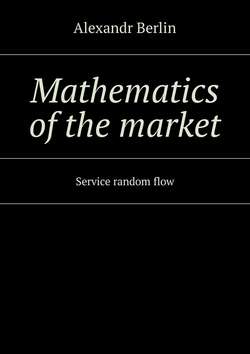Читать книгу Mathematics of the market. Service random flow - Alexandr Berlin - Страница 7
Chapter 1. What are the REELECTION CONSUMPTION. unit of measure of supply and demand
1.3. 3. The dependence of demand in units of relative consumption from the price
ОглавлениеWe determined the relative consumption as
a=Preal/Pmax
We will assume that the unit price the real and maximum consumption is equal; in this case the specific relative consumption does not depend on prices.
If these prices are different, it is possible to introduce coefficients.
Real consumption constitutes the sum of values relative consumption of certain groups of consumers.
Additivity of real consumption will be shown below.
A =Σ niai
Where n is the number of groups of consumers.
The increase in demand can have two sources:
1. The increase in the consumption of individual consumers Preal.
2. The increase in consumption due to the increase in the number of consumer groups.
3. Or the increase of both factors
When prices increase, real consumption is reduced, this leads to lower relative consumption. Conservation measures of the market require an increase in numbers buyers – n. If consumption is reducing then this can only be done by increasing the number of buyers, either through advertising or through the expansion of sales territory.
If prices fall, then real consumption is increases, then same number of buyers buys more goods. The limit this growth is Pmax.
At the stage when the market is not saturated with goods, the factors of maintaining the input flow are valid.
In case of market saturation (overproduction stage) Preal stops growth (every consumer receives the goods close to the maximum consumption). A numbers of groups of consumption at the saturation point, in most cases, cease to grow. During the production of the goods and preference for certain firms, consumer groups and the influence of other factors, such as the geography of sales is stabilized.
Therefore, manufacturers with capacity of production over a certain size (as we will show below) suffering losses, especially when the prices fall.
In this case, the main exit is the agreement to reduce output. This agreement applies to the type of “Nash equilibrium” [3.4]. This agreement brings to all parties to the losses, but the abandonment leads to even greater losses. Such agreements can be reached with great difficulty. This is true in general for the industry.
However, if we consider individual participants of market, the decline in the prices can increase number of groups of consumers which use product this participants reducing the number of consuming products of the other group manufacturers. Competition in the form of lower prices between manufacturers can limit only prime cost. This contest wins by the party that has the least cost, or he can get outside support (from government, banks, etc.).
Non-price factors that affect real consumption [4.4], and which can be influenced a relative consumption:
• The level of income in the society;
• The size of the market;
• Fashion, seasonality;
• Availability of substitute products (substitutes);
• Inflationary expectations.
Resume
So we have established General properties of the concept “the goods”.
It is despite of the large variety of goods, we reduced quantitative characteristics of the goods up to the two indicators.
1. The maximum possible consumption.
2. The real consumption.
However, if we consider the individual participants of market, the decline the prices individually participants of the market (by manufacturers) can increase number of groups of consumers which use his products by reducing the number consuming of products of the other group manufacturers. Competition in the form of lower prices between manufacturers will is limit only prime cost. This contest wins by the party that has the least cost, or he can get outside support (from government, banks, etc.).
In the future we will divide incoming supply of goods and supplies goods which already were serviced. (by analogy with the concepts of the theory of mass service [2.1] – the offered load and. the carried out load).
Incoming supply of goods in the time interval (t1, t2) denoted by Ainc. (t1, t2), it is represents the sum of the quantities of goods handled by this consumer group during the period (t1, t2).
Supplies of goods which already were serviced. over a period of time (t1, t2) is called such the supply of goods if each incoming goods will immediately purchased by the consumer – in moment. (t1, t2). Sometimes this supply will be called – a potential supply.
The difference between the incoming supply of goods and supplies goods which already were serviced will be called a” the losses supplies of goods” :
Alost (t1, t2)=A income (t1,t2)– Aserved.. (t1, t2)
